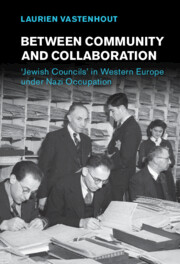Book contents
- Between Community and Collaboration
- Studies in the Social and Cultural History of Modern Warfare
- Between Community and Collaboration
- Copyright page
- Dedication
- Contents
- Illustrations
- Preface
- Abbreviations
- Introduction
- 1 Disrupted Communities?
- 2 Institutional Rivalry and Improvisation
- 3 Leadership of the ‘Councils’
- 4 Optimism and Frustration
- 5 Between Legality and Illegality
- Epilogue
- Bibliography
- Index
1 - Disrupted Communities?
Jewish Leadership and Communal Representation to 1941
Published online by Cambridge University Press: 15 September 2022
- Between Community and Collaboration
- Studies in the Social and Cultural History of Modern Warfare
- Between Community and Collaboration
- Copyright page
- Dedication
- Contents
- Illustrations
- Preface
- Abbreviations
- Introduction
- 1 Disrupted Communities?
- 2 Institutional Rivalry and Improvisation
- 3 Leadership of the ‘Councils’
- 4 Optimism and Frustration
- 5 Between Legality and Illegality
- Epilogue
- Bibliography
- Index
Summary
This chapter explores the structure of society and the composition of the Jewish communities in the Netherlands, Belgium and France from the late nineteenth century until 1941 (when the ‘Jewish Councils’ were established). It highlights the similarities and differences between the three countries’ social structures in this period. These include the number and outlook of (Eastern European) Jewish immigrants, the presence of official religious Jewish representation and Jewish integration in non-Jewish society in each case. Central themes are the level of integration of Jews into the non-Jewish communities, the position of immigrant Jews vis-à-vis the longstanding Jewish population, the level of religious adherence, the influence of Zionist thinking, the role of religious institutions and the organisational structure of the Jewish communities. This chapter also examines the institution of Jewish refugee organisations in the 1930s, and the position of the later chairmen of the “Jewish Councils” in Western Europe in these pre-war refugee aid organisations. Moreover, it addresses the establishment of so-called Coordinating Committees in 1940, either by German demand, or by initiative of Jewish community members, which aimed to oversee all Jewish philanthropic work and sought to unite the various Jewish communities. It argues that the supposed failures of these committees served as the springboard for establishing the ‘Jewish Councils’.
- Type
- Chapter
- Information
- Between Community and Collaboration'Jewish Councils' in Western Europe under Nazi Occupation, pp. 21 - 55Publisher: Cambridge University PressPrint publication year: 2022



